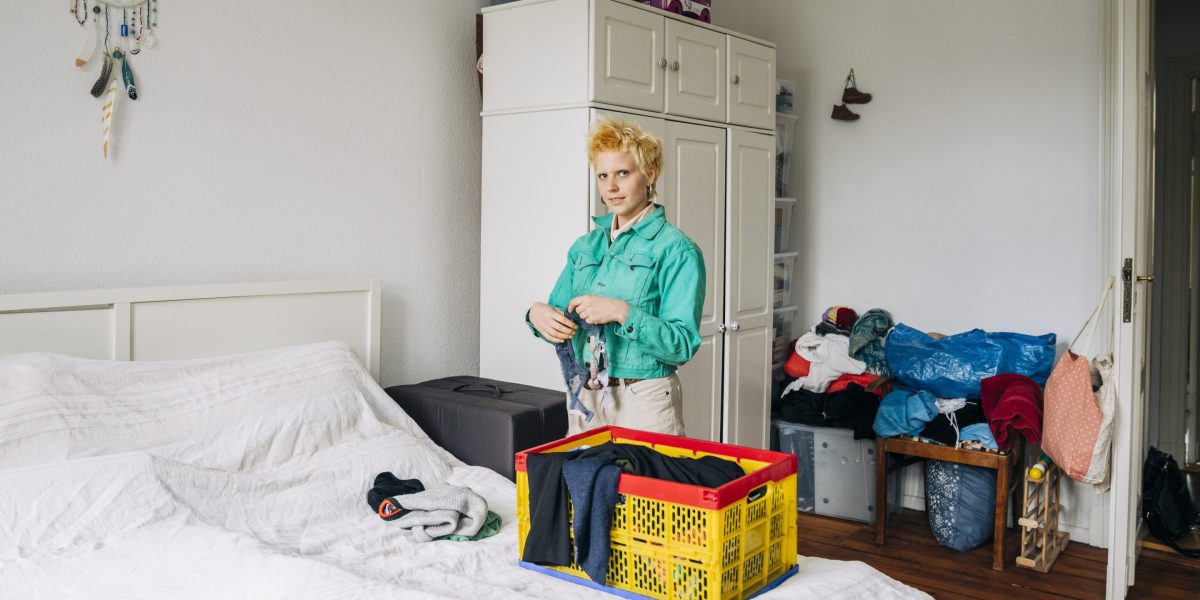It’s finally cool to still wear clothes you bought in middle school and show off your studio apartment with no art on the walls. Don’t call it being broke, Gen Z says; it’s “underconsumptioncore.”
The viral tag on TikTok is filled with young people showing off ways in which they’re choosing not to buy new products in favor of using the ones they have. From limiting themselves to one scuffed-up Stanley water bottle to opting out of doing one’s nails or buying art for their homes, Gen Z has eschewed buying new items in favor of trying to appreciate what they have.
Adeline Um, a 27-year-old living Boston musician, has recommitted to using every ounce of skincare products from their bottles, as well as continuing to use scruffed-up but functional makeup brushes and wearing 15-year-old clothes. She became exhausted watching TikToks from influencers and content creators peddling the newest item that would be trendy for only a couple of days before a shiny new item would take the spotlight.
“To want to purchase items isn’t bad,” Um told Fortune. “But I just feel like right now we’re getting an oversaturation of just people feeling like they have to buy the newest thing to keep up.”
Underconsumptioncore is a cousin of the de-influencing movement on TikTok, in which users convinced viewers to not buy the trendiest item being advertised to them by the slew of content creators with brand deals. While the influencer market is expected to balloon to $50 million by 2028, some young people are denouncing the rampant consumerism it breeds.
For a generation riddled with anxiety about their financial futures and the environment, these trends are empowering and attainable. According to Bank of America’s 2024 State of Gen Z’s Financial Health report released this month, among 1,091 Gen Z adults surveyed between April and May, over 50% of the young generation believe cost of living is their biggest financial challenge and greatest barrier to success.
“They’re feeling the high cost of living,” Holly O’Neill, president of retail banking at Bank of America, told Fortune. “They know they need to set a budget, and they know they need to find ways to cut back, and they look at those budgets…in order to meet those priorities.”
No need for shiny new things
Underconsumptioncore, though built on the foundations of financial savviness, has transcended socioeconomic status and the need to just save money. Um and her husband have remained financially stable through career changes and the pandemic but continue to be frugal with their purchases.
“It just gets so tiring watching people tell me that this is the newest thing that I have to buy,” she said.
For Um, the intention around spending was a respite from trend cycles that have dominated the internet. As addictions to scrolling had fed anxiety and depression among young adults, Gen Z has become increasingly sensitive to screen time, turning to flip phones for digital detoxes.
But having spent a year in her husband’s native England, Um gathered an appreciation for the quiet of the countryside. Um’s own parents immigrated to the U.S. from South Korea, where food was scarce. To feed her family, Um’s grandmother became adept at cooking whatever was available. Spending time between her parents’ and grandparents’ houses, Um garnered deep appreciation for the joy of harvesting food from a small backyard garden.
“I’ve kind of learned how to do that as well,” she said. “I really dislike throwing away food or like when food is rotting. I just feel so guilty about that.”
For Sabrina Pare, a 31-year-old content creator in Detroit, guilt has also motivated her to be mindful of her spending. Underconsumption is not a new concept in the world of sustainability, about which Pare makes her TikToks. To her, it’s a continuation of upcycling, or repurposing items that could be easily thrown away but instead are given a new life. But while these trends help Pare make her living making content online, even she’ll admit they can only take her so far in addressing climate change.
“The planet just keeps on getting warmer and, obviously, participating underconsumptioncore isn’t going to solve it,” she said. “But it does help me at least feel a bit more in control of the actions I’m taking.”
Even if participating in underconsumption is not economically necessary for its participants, it’s still consistent with the younger generation’s narrative of bringing deep awareness to their own financial wellbeing, O’Neill argued. The trend aligns with O’Neill’s observations about the generation’s financial patterns, which include lower discretionary spending, and doling out dollars methodically, preferring to buy store or bargain brand items over luxury items.
“You don’t want to waste the thing that you’ve already invested in or purchased; you want to optimize that,” she said. “That both has a budget and a sustainability impact. I mean, we all know the satisfaction of using everything that you purchase and not wasting it. Gen Z is very attuned to that.”
Despite its virality, underconsumptioncore will likely not radically change spending trends, she said. These online trends exist because of a generation’s broader ideas about the economy, but they likely don’t sway them.
Um will be the first to admit she isn’t immune to influencing and won’t make any promises about not buying a particular item. But TikTok trends around spending and personal finance are still welcome on her For You Page.
“You don’t need to buy a new set of hair straighteners just because your current ones are crusty,” she said. “If it still works, it still works. For me, it’s actually been a great reminder.”


